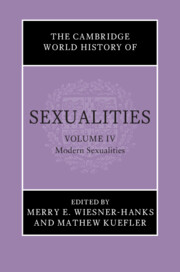Book contents
- The Cambridge World History of Sexualities
- The Cambridge World History of Sexualities
- The Cambridge World History of Sexualities
- Copyright page
- Contents
- Figures in Volume IV
- Contributors to Volume IV
- Editors’ Preface to the Series
- 1 Sexuality and Capitalism
- 2 Colonialism and Modern Sexuality
- 3 Gender, Migration, and Sexuality in the Modern World
- 4 ‘Pornography’, ‘Obscenity’, and the Suppression of Libertine Literature
- 5 Sexuality and the Print Media in the Modern World
- 6 Eugenics, Public Health, and Modern Sexuality
- 7 Sexuality and Consumerism in the Modern World: The Business of Pleasure
- 8 Sex Education in the Modern World
- 9 Birth Control and Reproductive Rights in the Modern World
- 10 The Impact of the World Wars on Modern Sexuality
- 11 Sexualities and Dictatorships of the Twentieth Century
- 12 Sexuality in Post-war Liberal Democracies
- 13 The Sexual Revolution
- 14 Sex Tourism: Fluid Borders of Meanings and Practices
- 15 The History of AIDS since 1981: Medicine, Politics, and Societies in a Pandemic
- 16 Sex Trafficking in the Modern World
- 17 Sex, Law, and Domestic Violence against Women in the Modern World
- 18 Sexuality under Attack Now
- Index
- Contents to Volumes I, II, and III
- References
4 - ‘Pornography’, ‘Obscenity’, and the Suppression of Libertine Literature
Published online by Cambridge University Press: 26 April 2024
- The Cambridge World History of Sexualities
- The Cambridge World History of Sexualities
- The Cambridge World History of Sexualities
- Copyright page
- Contents
- Figures in Volume IV
- Contributors to Volume IV
- Editors’ Preface to the Series
- 1 Sexuality and Capitalism
- 2 Colonialism and Modern Sexuality
- 3 Gender, Migration, and Sexuality in the Modern World
- 4 ‘Pornography’, ‘Obscenity’, and the Suppression of Libertine Literature
- 5 Sexuality and the Print Media in the Modern World
- 6 Eugenics, Public Health, and Modern Sexuality
- 7 Sexuality and Consumerism in the Modern World: The Business of Pleasure
- 8 Sex Education in the Modern World
- 9 Birth Control and Reproductive Rights in the Modern World
- 10 The Impact of the World Wars on Modern Sexuality
- 11 Sexualities and Dictatorships of the Twentieth Century
- 12 Sexuality in Post-war Liberal Democracies
- 13 The Sexual Revolution
- 14 Sex Tourism: Fluid Borders of Meanings and Practices
- 15 The History of AIDS since 1981: Medicine, Politics, and Societies in a Pandemic
- 16 Sex Trafficking in the Modern World
- 17 Sex, Law, and Domestic Violence against Women in the Modern World
- 18 Sexuality under Attack Now
- Index
- Contents to Volumes I, II, and III
- References
Summary
This chapter is a comprehensive history of sexually-explicit literature drawn from books banned and prosecuted in Asia and Europe, sixteenth to twentieth centuries. The prurient treatment of sexual violence and the lewd mockery of authority form part of this discourse, yet law and censorship denied its literary value, reduced all erotica to the most basic “obscenity” or mere “pornography” (literally, “whore-writing”), and sometimes put the author to death. (Paradoxically the cultures richest in sex-writing also suppressed it most fiercely.) Here is a more complex history, hybridizing multiple genres: manuals of sexual positions, courtesans” autobiography, satire against hypocrisy and repression, philosophies of mind, body, and desire – normally homoerotic, though in China and the West true knowledge of sexuality is represented as female, passed down by mistresses of the secret arts providing instructions for the wedding night (and beyond). The phallus was even gendered female. Libertinism continued to explore same-sex desire (especially in Italy and Japan), while its heteronormative branch dissociated sexuality from procreation, insisting that biological sex should be transformed into an art of aesthetic “transmutation”, urging women to pursue erotic pleasure as a supreme end in itself – centuries before contraception made this realistic. Feminocentric and masculinist perspectives intertwine.
- Type
- Chapter
- Information
- The Cambridge World History of Sexualities , pp. 71 - 93Publisher: Cambridge University PressPrint publication year: 2024



